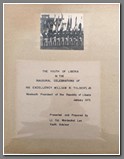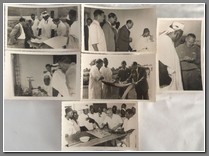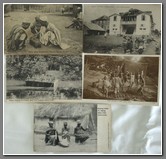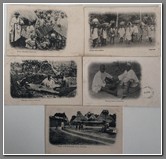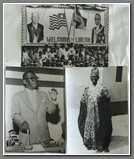The Youth of Liberia in the inaugural celebrations of his excellency William R. Tolbert Jr. nineteeth President of the Republic of Liberia, January 1972. Presented and prepared by Lt. Col. Mordechai Lev youth advisor. A rare and uniqe photo album with 15 original black and white photographs, (4 of which are captioned in Hebrew) and 22 original-colored photographs. The demonstrations were prepared by the BUREAU OF YOUTH, assisted by two experts from ISRAEL, Mr AVRAM GINO and Mr. JACOB SHEMER. The album ends with hebrew newspaper article and 5 photos of politicians from Israel and Liberia, and the presidents of the Supreme Court of Israel and Liberia.
Price: $600.00
NOTE: On 9 April 1959, Israel made its first agreement with an independent African nation in its treaty of friendship with Liberia. Between 1959 and 1973, Israel and Liberia would make five more agreements. In this same period, Israel would receive one state visit from Liberia in June 1962, when President Tubman visited Jerusalem. Liberia would receive two state visits from Israel, one from President Yitzhak Ben-Zvi to Monrovia in August 1962, and one from Prime Minister Levy Eshkol in June 1966. BRA 210
BRA 210
Israel helped to contribute to President Tubman's Open Door Policy in the late 1950s. This policy's goal was to bring economic development to Liberia's interior. This involved foreign financial investment, as well as development of its mining and agricultural industries. In the late 1950s, two surveys were conducted by Israeli experts in regard to the agricultural possibilities of Liberia. Private Israeli businesses also provided both large scale construction projects, such as with the Ducor Hotel and a new Executive Mansion, in addition to smaller projects. Israel also helped develop Liberia's medical capabilities.
 BRA 210President William Tubman was a proponent of Israel, and throughout his term in office, he resisted pressure from the Organisation for African Unity (OAU) to oppose Israel. In 1967, after the Six-Day War, Liberia was the first African country to move its embassy in Israel to Jerusalem. It was shown in declassified documents from the Israeli Ministry of Foreign Affairs that diplomatic officials in the Tubman administration, including representatives to the UN, were bribed by Israel in the form of cash and gifts in exchange for diplomatic support.
BRA 210President William Tubman was a proponent of Israel, and throughout his term in office, he resisted pressure from the Organisation for African Unity (OAU) to oppose Israel. In 1967, after the Six-Day War, Liberia was the first African country to move its embassy in Israel to Jerusalem. It was shown in declassified documents from the Israeli Ministry of Foreign Affairs that diplomatic officials in the Tubman administration, including representatives to the UN, were bribed by Israel in the form of cash and gifts in exchange for diplomatic support.
Upon Tubman's death in 1971, he was succeeded by Vice President William Tolbert. Tolbert was not as supportive of Israel or the Western Bloc as his predecessor. He sought more relations and economic ties with Asian countries, such as the People's Republic of China, and Arab countries. Tolbert also increased Liberian identification with the Non-Aligned Movement. During the OAU summit in Rabat in June 1972, Liberia supported a resolution calling for Israel to withdraw from occupied territories acquired in the Six-Day War. On 2 November 1973, the Tolbert administration severed ties with Israel in response to the Yom Kippur War, along with 28 other African countries. While their formal relations were undone, Liberia maintained some contact with Israel through intermediates, such as private Israeli businesses and international organizations like the United Nations. While Israel–Liberia relations were worsened, Tolbert continued to support the existence of the Israeli state, and supported the continuation of Israel's status as a member state of the United Nations.

